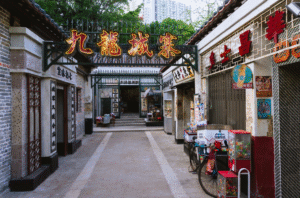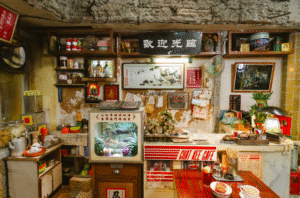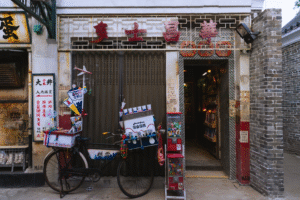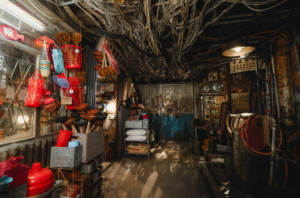Kowloon Walled City: A Cinematic Journey
The exhibition Kowloon Walled City: A Cinematic Journey invites visitors to explore the fascinating yet complex history of the Kowloon Walled City through the lens of cinema. Inspired by the award-winning film Twilight of the Warriors: Walled In, which offers a dramatised portrayal of life within this unique urban enclave, the exhibition recreates key movie scenes at the original site of the story – the former Kowloon Walled City (now Kowloon Walled City Park).
This open-air exhibition marks Hong Kong’s largest-scale movie set exhibition to date and will be running for three years. The exhibition’s earlier version held at the airport and Airside shopping centre in Kai Tak was particularly well-received by the public, attracting more than 180,000 people between December 2024 and February 2025.
The movie Twilight of the Warriors: Walled In portrays the gritty reality of life in Kowloon Walled City, focusing on the stories of its residents and the challenges they faced. The film captures the essence of the Walled City, showcasing its communal spirit, struggles and the often-overlooked humanity within its confines.
The exhibition builds upon the film’s narrative, featuring key scenes, props and installations that allow visitors to step into the world depicted on screen. It highlights the juxtaposition of the cinematic representation with the real-life experiences of those who lived in the Walled City, providing a deeper understanding of its cultural significance.
Numerous iconic scenes from the movie have been reconstructed, including No.7 Restaurant, barber shop, dental clinic, grocery store, bone-setting clinic, fish ball factory, tailor shop, repair shop, communal well, and plastic molding workshop along the city’s narrow alleys. Visitors can also explore the “Rooftop of Light and Shadow in the Walled City” that features large-scale projections revealing the day-and-night life of the Walled City, accompanied by immersive roaring of the low-flying aircraft over Kowloon City.
Elements of traditional local crafts are also included in the exhibition. The entrance features a hand-painted ceremonial flower board and an iron honorific arch that says “Kowloon Walled City”, a reference to the design of the gates in the 1980s. Some of the exhibition’s floor tiles are repurposed from old buildings, paying tribute to the iconic style of the era.
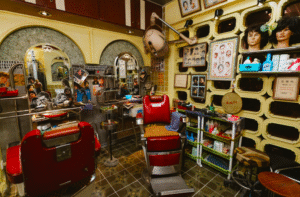
There was nothing like Kowloon Walled City, an improbable and anarchic settlement that stood as one of the most densely populated places on earth, caught between China and the British-run Hong Kong government.
From a quiet outpost for the salt trade during the Song dynasty (960–1279) to a military fort during the later years of the Qing Dynasty (1636-1912), the Walled City became a de jure enclave after the New Territories were leased to the United Kingdom in 1898, following the first Opium War.
In the 1950s, the population had grown to 17,000 residents. With no government enforcement from the Chinese or the British, the Walled City became over the years a place for unregulated businesses like brothels and opium dens, a haven for crime, gambling and drug abuse, ruled by the triads until the police conducted several raids in the late 1970s.
By the end of the 1980s, the Walled City was home to about 35,000 residents, disseminated within 2.6 hectares and 350 buildings, occupied by 8,500 premises and 10,700 households, as well as shops and factories. Small property developers were constantly expanding the buildings to accommodate thousands of new migrants, without following any architecture guidelines or safety regulations.
The city became known for its cheap doctors and dentists who emigrated from China with no valid license in Hong Kong. Hundreds of factories produced everything from fish balls, candies to golf balls. There was a cotton mill and garment factories, and plenty of small workshops.
The lack of governance, the separation from Hong Kong and the difficult living conditions created a distinct culture within the city, with residents forming a tightly knit community. The rooftops were like a sanctuary, the main gathering place to escape claustrophobia and perpetual darkness. Parents would come to relax, and children to play or do their homework, supervised by the grandmothers.The yamen courtyard was also a major social centre, a place for residents to talk, have tea, watch television or even take calligraphy classes.
After a difficult eviction process, the demolition began in 1993 and was completed in 1994. The Kowloon Walled City Park opened in 1995. A rewarding number of relics was unearthed, nearly all of which were incorporated in the design or preserved as exhibits. The yamen was classified as a declared monument, as well as the original site of the South Gate.
The exhibition Kowloon Walled City: A Cinematic Journey not only celebrates the artistic interpretation of a unique urban environment but also serves as a poignant reminder of the resilience and creativity of its inhabitants. By intertwining the cinematic and the historical, the exhibition offers a multifaceted look at a place that has left an indelible mark on Hong Kong’s cultural landscape.
More details about the exhibition can be found here: Kowloon Walled City: A Cinematic Journey
